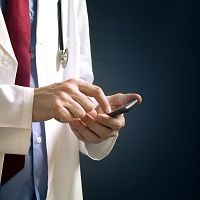Smartphone App Could Double as Ophthalmology Tool
Patients diagnosed with diabetic retinopathy may be able to get a sense of how their condition has progressed without having to leave the comfort of their own home.

Patients diagnosed with diabetic retinopathy may be able to get a sense of how their condition has progressed without having to leave the comfort of their own home.
At its annual conference in Chicago the America Academy of Opthalmologists announced a new smartphone app which could help measure and grade the severity of the disease. “The results of the research indicate the lower-cost method could be used for bringing the service to patients in isolated or underserved communities,” the Academy said in a statement.
Diabetic retinopathy affects approximately 7.7 million people in the United States, according to the statement. The cause for most cases is elevated blood sugar, which can eventually lead to partial vision loss and eventually total blindness. Patients are currently tested in a doctor’s office with a retinal slit-lamp biomicroscopy.
While the test can determine a person’s visual condition the statement said it is not always easy for patients to get the treatment they need.
“This kind of examination requires a large piece of specialized equipment found only in clinical settings, posing a significant challenge for monitoring patients living in rural or low-resource communities,” the statement noted.
The technology for the new test was developed by researchers from the Universities of Brescia, Molise, and “Federico II.” As part of their work, the team created a “small optical adapter” called a D-Eye, which would attach to a patient’s iPhone5 making a virtual ophthalmoscope.
Using their newly created device and the traditional mechanism, the researchers tested 120 diabetic patients who had been previously scheduled for an eye exam. The data showed that the two tests provided identical results in 85% of patients and were within “one step” in 96.7% of eyes. “In most of the one- and two-step disagreements, the severity level was graded higher by biomicroscopy grading,” the statement said.
While the traditional machine was unable to grade the eye of 4 patients, the iPhone version was unable to get a reading in 9, showing some benefits to the original test, the statement noted. The researchers still said the new way of testing can provide great benefits for the people who need it as the technology advances.
“Using the iPhone method is thousands of dollars cheaper than using traditional equipment,” said lead researcher Andrea Russo, MD. “The affordability of this option could make it much easier to bring eye care to non-hospital remote or rural settings, which often lack ophthalmic medical personnel.”